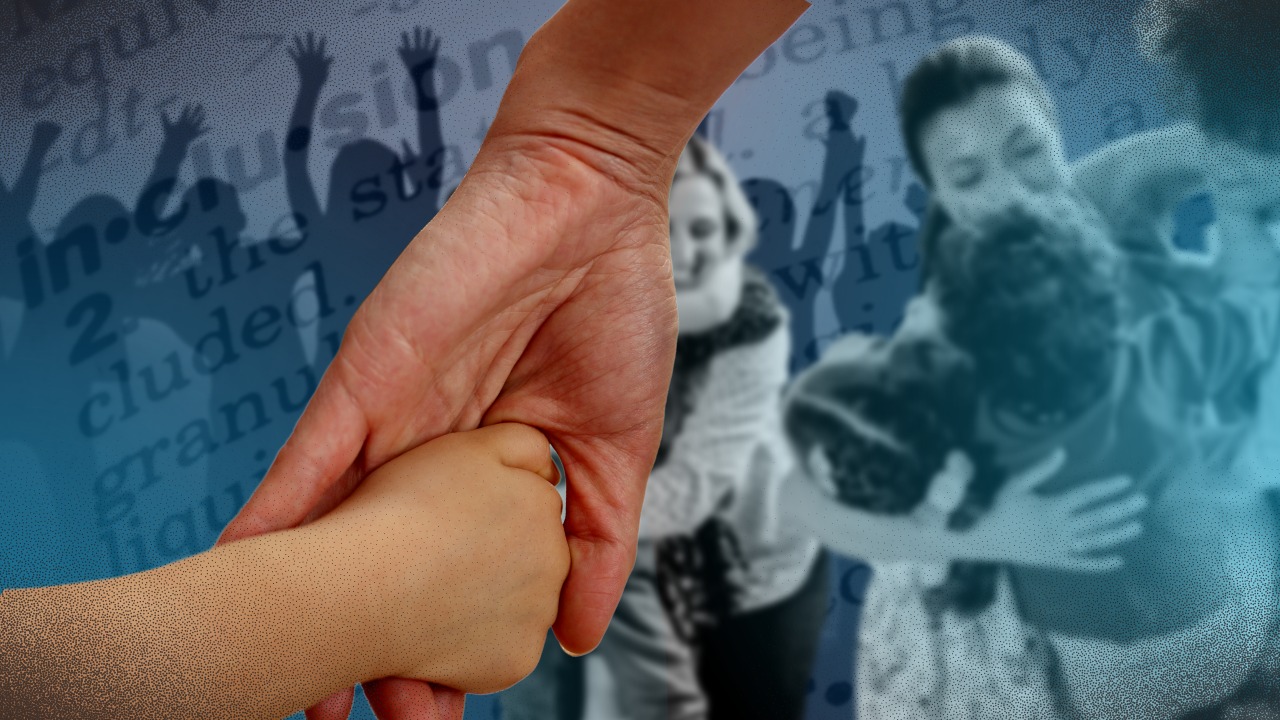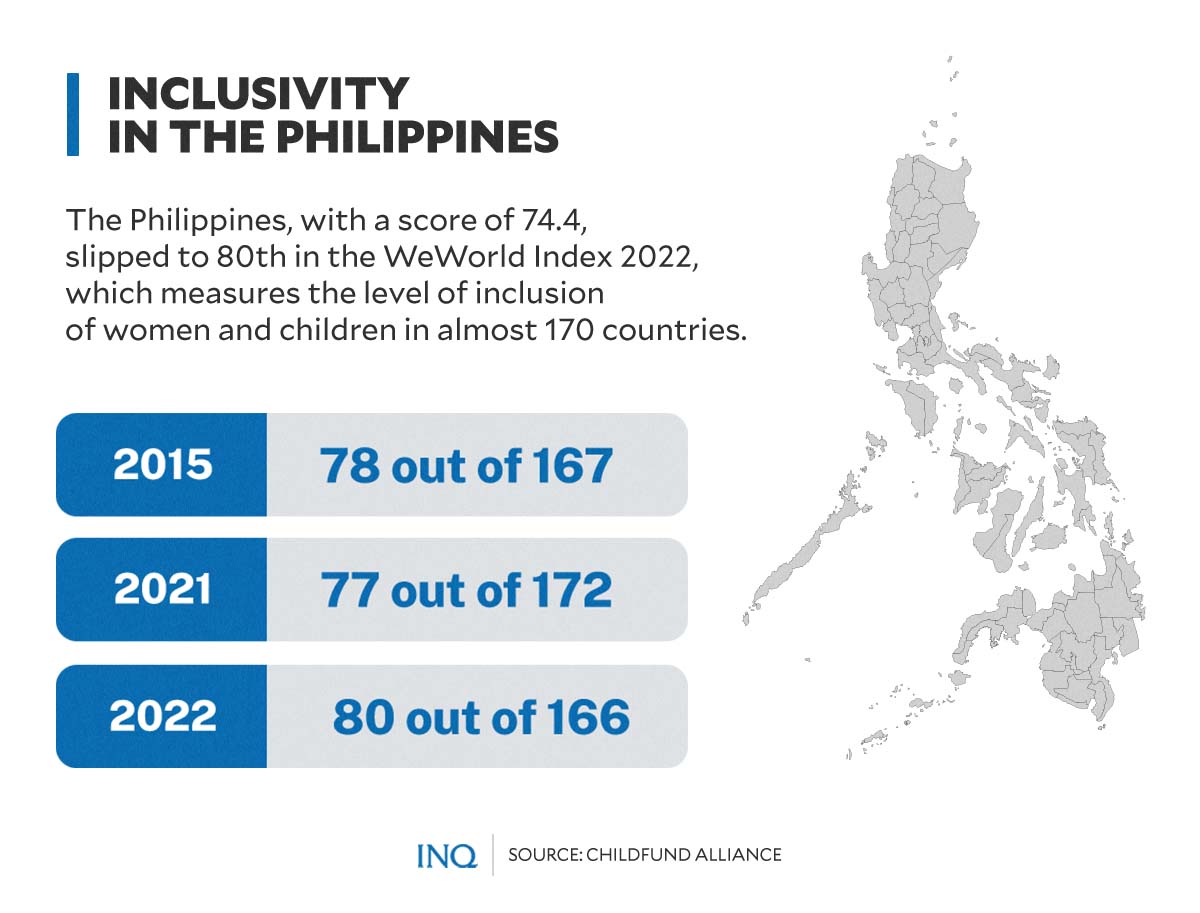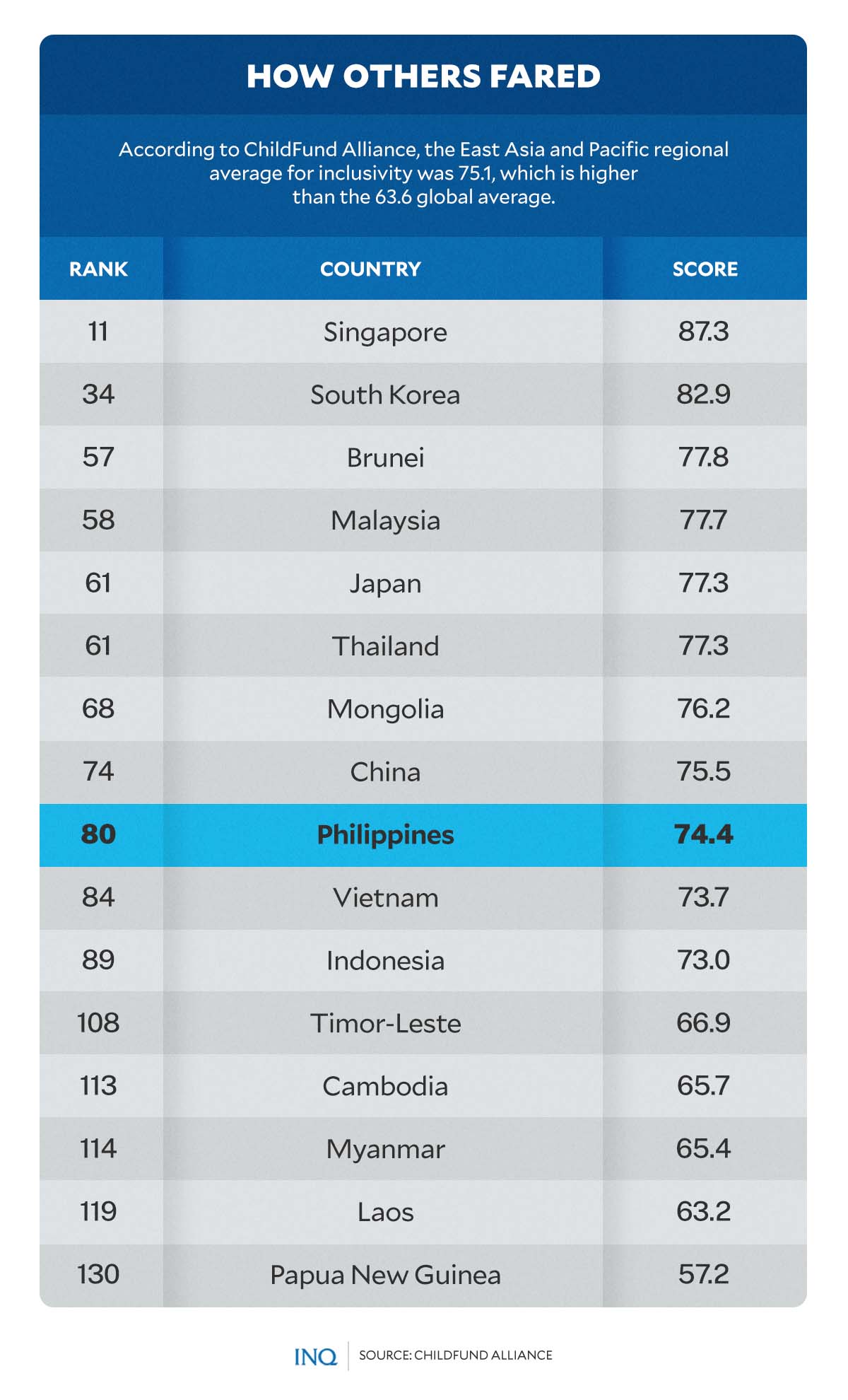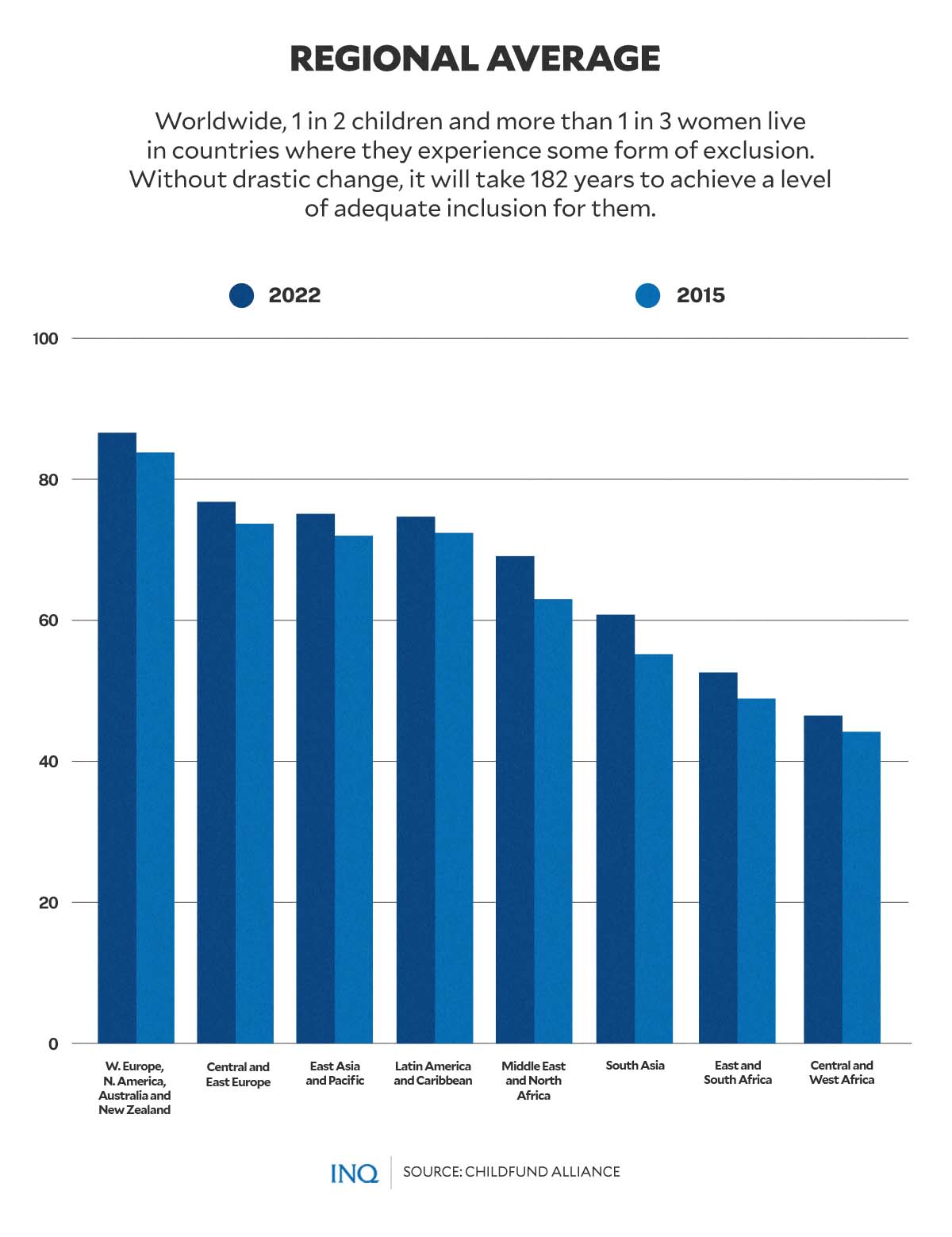PH slips in inclusion index, putting women, children at risk

INQUIRER FILE PHOTO
MANILA, Philippines—“No one should be left behind” was the ultimate goal of the 2030 Sustainable Development Agenda, but as “cascading and interlinked” global crises slowed progress toward achieving this, millions of women and children are now at risk of being left at the rear.
This was stressed by officials of WeWorld and ChildFund Alliance as the 2022 WeWorld Index, which monitors the living conditions of women and children in almost 170 countries, was released, highlighting the barriers that hinder their future.
As stated by Simon Whyte, chair of ChildFund Alliance, new and evolving barriers—poverty, conflict, forced migration, climate change, and online risks—“are currently affecting millions of women and children, and they inevitably will affect exponentially more, if left unaddressed.”
“These risks include global events such as the COVID-19 crisis, the invasion of Ukraine, increasing drought conditions affecting food production, and rising global temperatures that are making insufferable heat waves more the norm,” he said
It was stressed by Whyte that such events are resulting in surges in mass migration, school closures, poverty, food insecurity, illness and death. Likewise, he said: “They are creating increased risks to children as millions more go online for learning and socialization.”
Regrettably, Filipino women and children were not spared from these challenges as the Philippines, which received a score of 74.4 in inclusivity, slipped to 80 this year from 77 in 2021 and 78 in 2015.

GRAPHIC Ed Lustan
The countries that received a score equal or more than 85 have “very good inclusion” for women and children, while those that got 75 to 84 have “good inclusion,” 65 to 74 indicates “sufficient inclusion,” 55 to 64 means “insufficient inclusion,” while 45 to 54 and equal or less than 44 indicate “severe exclusion” and “very severe exclusion.”
Based on data from the ChildFund Alliance, the Philippines is among 38 countries considered to have “sufficient inclusion,” next to Ecuador (74.6), Brazil (74.7), and Paraguay (74.9).
This, as the Philippines, out of 166 countries, was at 97th in the Context Sub-Index, which looks at the contexts in which women and children live. The country was 93rd in the Children’s Sub-Index then 63rd in the Women’s Sub-Index, the ChildFund Alliance said in its report that was released last week.
Lower than regional average
While the Philippines’ score was higher than the global average, which was 63.6, it was still lower than the 75.1 average score in East Asia & Pacific—the third region with the highest average.
West Europe, North America, Australia and New Zealand (86.6) and Central and East Europe (76.8) were the regions with the two highest averages. The rest of the regions on the list were Latin America and Caribbean (74.7), Middle East and North Africa (69.1), South Asia (60.8), East and South Africa (52.6), and Central and West Africa (46.5).
As stated by the ChildFund Alliance, Singapore, which was 11th in the 2022 WeWorld Index, was the country in East Asia and Pacific that received the highest score—87.3. Next to it were South Korea (82.9), Brunei (77.8), and Malaysia (77.7).
Then next to Malaysia were Japan (77.3), Thailand (77.3), Mongolia (76.2), China (75.5), Philippines (74.4), Vietnam (73.7), Fiji (73.5), Indonesia (73.0), Timor-Leste (66.9), Cambodia (65.7), Myanmar (65.4), Laos (63.2), Vanuatu (62.0), and Papua New Guinea (57.2).

GRAPHIC Ed Lustan
The ChildFund Alliance said East Asia and Pacific were among the regions that had the most considerable progress in the Context Sub-Index and Women’s Sub-Index, but were the only region to experience a worsening in the conditions of children.
It was stressed that ever since the 2030 Sustainable Development Agenda was launched in 2015, “the world has become less inclusive for children, making it even harder to achieve the Sustainable Development Goals in this last Decade of Action” and that “the ‘children’s education’ dimension has suffered the most serious deterioration.”
Barriers
As stressed by the ChildFund Alliance, five global barriers are holding back the achievement of an adequate level of inclusion: poverty, conflict, forced migration, climate change and online risks for children.
Based on data from World Bank as of 2020, 10 percent of the world’s population still lives in extreme poverty, and the most at risk groups are disproportionately affected. Among them, children are more than twice as likely to be poor as adults.
With one in six children living in a conflict zone, as revealed by the Peace Research Institute of Oslo, the ChildFund Alliance said “the impacts of conflicts do not cease to exist when the attacks are over, but unfold themselves in their aftermath, with devastating consequences, especially for the most vulnerable people.”
Likewise, according to the United Nations Children’s Fund, almost one in three children living outside their countries of birth are child refugees. For adults, the proportion is less than one in 20.
It was also stressed that climate change, which is triggered mainly by high-income countries, will have catastrophic effects, especially on low-income countries and the most vulnerable like women, children, adolescents, and indigenous communities.
But as life becomes digitized, incidents of digital harm will also increase, the Child Fund Alliance said, explaining that online risks are all the adverse situations one can encounter while navigating the virtual world—cyber-bullying, sexual exploitation, abuse, grooming, and exposure to illegal content.
Based on data from the Interpol, every day, seven victims of online child sexual exploitation are identified all over the world.
WeWorld dimensions
The WeWorld Index, published every year since 2015, arises from the need to illustrate the living conditions of women and children worldwide. It is a composite index that measures women’s and children’s inclusion in key dimensions:
- Environment
- Housing
- Conflicts and wars
- Democracy and safety
- Access to information
- Children’s health
- Children’s education
- Children’s human capital
- Children’s economic capital
- Violence against children
- Women’s health
- Women’s education
- Women’s economic opportunities
- Women’s decision-making participation
- Violence against women
It was stressed that the dimensions, which were introduced in the latest edition of the WeWorld Index, allows for additional processing—assessing whether and how the 15 dimensions that make up the Index are correlated with each one.
“It is evident that the context in which one is born plays a key role in determining living conditions […] The ‘Housing’ dimension has strong correlations not only with other context dimensions, but also with women’s and children’s health and education, the violence perpetrated against them, and women’s economic opportunities.”

GRAPHIC Ed Lustan
“The right to adequate housing is essen5 In statistics, correlation is defined as any statistical relationship, whether causal or not, between two variables or data,” the ChildFund Alliance said.
“As conceivable, the ‘Democracy and safety’ dimension relates to ‘Conflicts and wars.’ In these times, it is good to remember that the state of health of a country, its social protection systems, and its citizens depend on its internal stability and institutions,” it stressed.
Inclusive development’s building blocks
As stated in the WeWorld Index, four areas of action to assert and exercise women’s and children’s rights are taken into consideration—health, education, the economy, and society.
“To achieve full inclusion of women and children, they must be put in the condition to develop their capabilities, implement their rights, and experience the positive power of doing and being what they want to be in the said areas.”
It was explained by the ChildFund Alliance, in each of the building blocks, women and children may be hindered in the acquisition of their capabilities by specific and mutual risk factors.
“The actions carried out in the four building blocks—aimed at fostering their capabilities and the norms modification—affect the environmental and cultural setting too, which contributes in turn to asserting new rights for everybody, including men.”
- Health
It said undernourished children experience growth issues and run a higher risk of being infected or dying, but also developing limited cognitive abilities, which will undermine their school performance.
Likewise, “an undernourished woman will have perinatal complications and give birth to premature or underweight babies, running higher risks of being infected or dying during delivery.”
- Education
If children have access to quality education early in their lives, they will perform better at higher school levels, run fewer risks of dropping out of school and earn high qualifications. They will become more aware and educated adults, and pass on to their children the value of education.
Educated women, meanwhile, have access to better paid and more protected jobs and can get back (earlier) to the paid labor market, with positive consequences for themselves and their children.
- Economy
It was explained by the ChildFund Alliance that children living in a family in good economic conditions, where both parents work and the woman is equal to the man, enjoy good health and have proper nutrition.
Parents in good economic conditions, especially mothers, invest more in their children’s education, even in the long term. Hence, their children run fewer risks of dropping out of school to contribute to family income or being abducted into the child-labor exploitation circuits.
“A working mother is a model for her children—above all for girls—and will guide them in their future choices. Girls will be more inclined to study longer and, in the future, to enter the labor market,” it said.
- Society
It was stressed that in a free and democratic country, women participate in public and political life, promoting gender and generational equality objectives, while women transmit to their children the value of honesty and democratic principles, fighting against corruption and practices damaging the collective well-being.
“If society recognizes children as legal entities, and their opinions are taken into consideration, they have negotiating power in the family, and their parents will be more likely to listen to them. “
Drastic change needed now
As revealed by the WeWorld and ChildFund Alliance, in seven years, the world has improved by only 1.4 points in the WeWorld Index, indicating that at this rate, it would take 182 years to achieve a level of adequate inclusion for women and children all over the world.
“Inclusion affects multiple spheres of life: from access to education, health services, and living in safe places, to equal rights in social participation—from access to public services to the ability to fully and freely express one’s personality.”
Marco Chiesara, president of WeWorld, said “the report highlights that the great challenge of our times is to guarantee a future for boys and girls.”
Meg Gardinier, secretary general of ChildFund Alliance, stressed that “it is critical that the world pay attention to how the effects of these five barriers intertwine with each other, creating a threatening combination that could potentially compromise the future of an entire generation and of those to come.”
“Though significant work remains ahead, I am encouraged by the collaborative efforts of ChildFund members and our partners to create a more inclusive world where children and women are guaranteed their rights and are able to achieve their full potential.”














